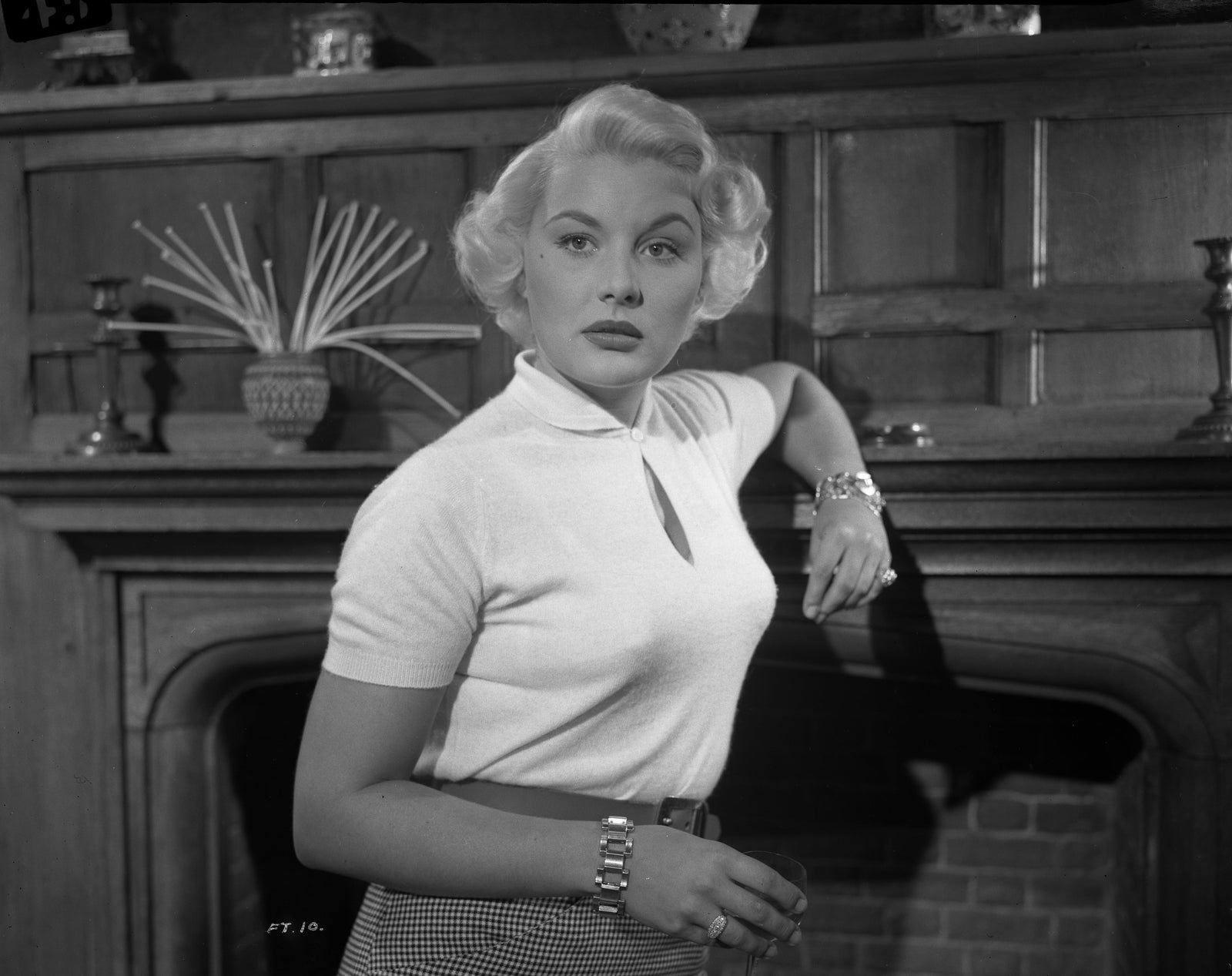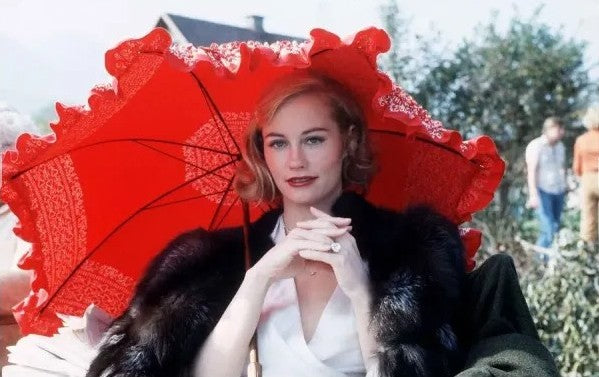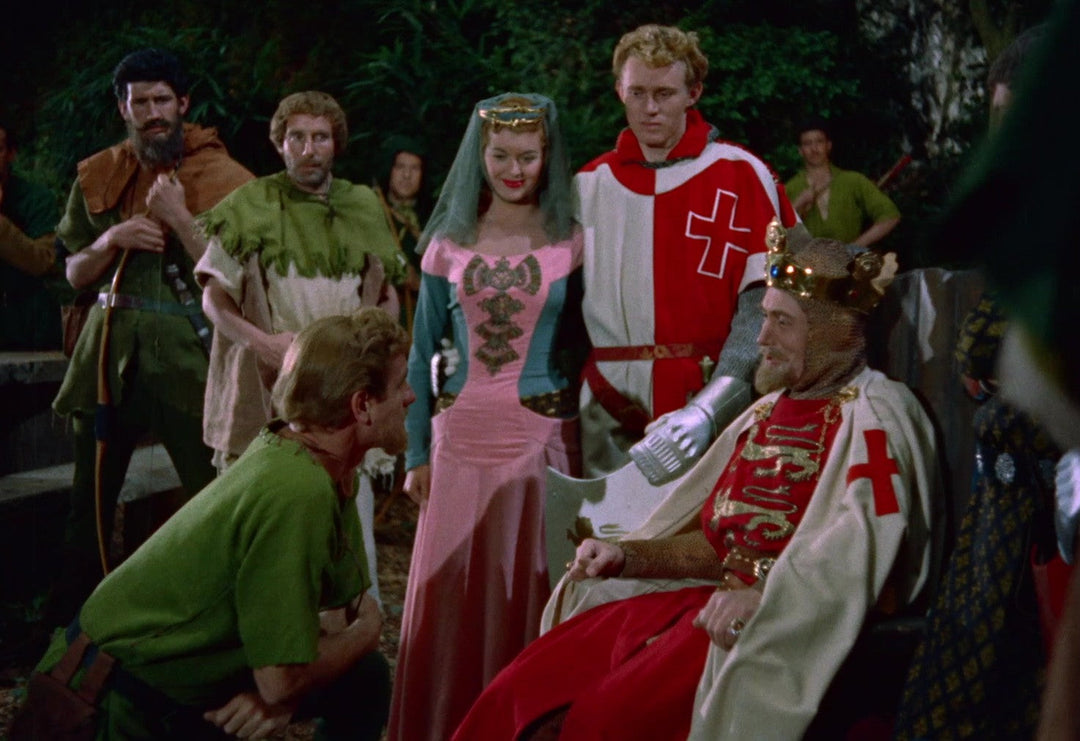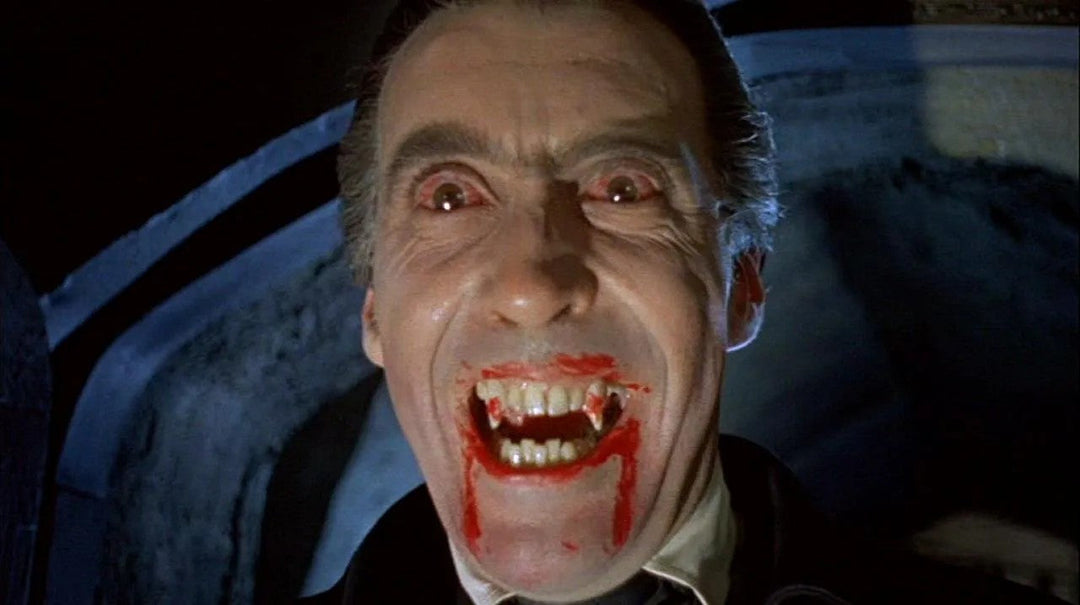Barbara Payton: Hollywood, Hammer and Playing the Cards

As the newly restored, 4K edition of Four Sided Triangle (1953) becomes available, we look on the final years and movies of its leading lady, Barbara Payton. We celebrate the remarkable presence she brought to her two Hammer outings and pause to reassess what made her such a remarkable performer.
You know your career’s in trouble when you’re playing the titular wife in a movie called Bride of the Gorilla. It wasn’t so long earlier that Barbara Payton had been, in her own words, the ‘queen bee’ of Hollywood. Pulling in $10,000 a week and starring opposite the likes of Gregory Peck, Gary Cooper and her childhood hero, James Cagney.
Years earlier she’d been discovered in the clubs that line Sunset Strip. Back in the late 40s, Andrew Lyles, a Paramount Pictures producer, was enjoying a drink or two in one of them – Ciro’s. The place to be. He was sat besides Joan Crawford, one of cinema’s hottest - and thorniest - stars. But when she glimpsed the young Payton across the room, even she was struck by her wow factor. ‘That is a very lovely, very sweet girl. Who is she? Where is she from?’ She turned to Lyles and said, ‘If her acting is as good as her looks, she is going to be big in this town!’
Joan was right. But in more ways than she knew. Payton became a big star. A big draw. And that brought its own set of troubles.

William Goetz, co-founder of Twentieth Century Pictures, who gave Payton her first acting contract.
The production chief at Universal-International Studios, William Goetz, first encountered Payton (born Barbara Lee Redfield in November, 1927) in another Hollywood club, Slapsy Maxie’s, where she was part of a variety revue show. Despite her lack of acting experience, he gave her a contract worth $400 per month because he’d been so bowled over by her luminosity and looks. Now, Tinsel Town has always been full of men and women loaded with luminosity and looks. There’s a dozen in every diner. Waiting tables. Or just waiting. Payton was different. She could act, sure, but the camera loved her. It captured her radiance and burnt it onto the big screen. The wow factor that had hit Joan Crawford between the eyes wasn’t filtered out. Her electric, real-life appeal was captured in every shrug, smile and arch of the eyebrow.

Payton, back on Sunset Strip in the 50s.
She began to earn bigger roles, win good reviews and the Hollywood Press Association hailed her ‘the most beautiful girl in pictures’. The starlet from Minnesota looked to be on a one-way journey to success. Her trip was derailed in brutal fashion when two of her paramours came to blows, with one of them, the actor Franchot Tone (an ex-husband of Joan Crawford) ending up in hospital after taking a beating from B-lister and part-time boxer, Tom Neal.
In truth, Payton’s so called ‘wild ways’ had already nudged her close to the edge of what her bosses would continue to accept. She’d had a string of high-profile, ill-advised affairs, clashed with studio heads and was known to associate with mobsters. But even though she wasn’t the one to throw a punch, this incident, so bloody and violent and public, pushed her over that edge of acceptability. The fight hit the headlines around the world. She married Tone a few weeks later, but couldn’t give up Neal. When their affair became common knowledge, it wasn’t a good look. She lost the lead in Lady In The Iron Mask (1952) and realised she had to adjust to a new reality.

Payton during a hospital visit to see Franchot Tone. She later described him as a ‘masochistic man who loves beauty for beauty’s sake’.
So here she was. 1951. The tail-end of a tumultuous year and Bride of the Gorilla opens to… not a lot. In fairness, it’s not a bad film. The story is packed with intrigue and passion and its title is misleading narratively, as well as thematically. If it had retained its working title – The Face in the Water – it would have worn a sheen of respectability befitting its terrific cast, with Raymond Burr and Tom Conway playing the two male leads, and the marvellous Paul Cavanagh popping up now and again to give an imperious sneer or two.
Best of all, Payton shows she’s lost none of her powers playing Dina Van Gelder, the wife of a much older husband who falls for a younger, more physical man, with catastrophic consequences. In fact, it’s frustrating to see what a fascinating dynamic she conjures up with the urbane Tom Conway who plays the sophisticated Dr Viet. When they’re not onscreen together the partnership is sorely missed. Their different styles work nicely in tandem and it’s unfortunate they never renewed this brief pairing.

From Bride of the Gorilla, (l-r) Tom Conway, Barbara Payton, Gisela Werbisek, Paul Cavanagh and Raymond Burr.
Talking Classics gave a shrewd assessment, calling Bride of the Gorilla ‘fun to watch… a guilty pleasure’ whilst noting its plotline is ‘silly but entertaining’. All true, but shot in ten days on a barely-there budget, it’s alarmingly static at times, contains some jarring cuts and despite director Curt Siodmak’s best efforts, some of the jungle sequences look faintly ridiculous.
So, when Payton was offered roles across the pond in Four Sided Triangle and The Flanagan Boy (1953), it probably didn’t take her long to decide that swapping Hollywood for Hammer was the smart move. She remained a ‘name’ and photographs taken on location prove the public was frantically eager to catch sight of her, and they quickly fell under her spell.

On location during the Four Sided Triangle shoot.
More importantly, she’s superb as Lena / Helen in Four Sided Triangle. Hammer’s Steve Rogers discussed her contribution to the film in a previous article but it’s perhaps worth singling out specific scenes that showcase her talent.
For instance, there’s a compelling exchange early on when Lena visits her childhood friend, the paternal Doctor Harvey. She relates her woes and essentially reveals she plans to take her own life. Payton lets Lena explain her tragic situation with barely any sorrow leaking into her voice. There’s no fuss. No fury. This is where she’s at, and she seeks neither pity or assistance. Payton delivers a masterclass in bruised nobility.
Lena’s words make it clear she’s suffering from some kind of depression, but Payton elects not to play her character with a handwringing, moping sadness. There’s defiance as she determines to go out on her terms, but compassion, too, as she recognises the anguish felt by Harvey. Watching her performance in this pivotal scene now, it feels perfectly weighted. People suffering from depression don’t always show their burden as overtly as some actors would have us believe, and over 70 years after shooting the film, Payton’s more delicate take on Lena feels modern and empowering for her character.

Payton with James Hayter who returned to the Hammer stable for A Challenge for Robin Hood (1967) and The Horror of Frankenstein (1970).
And watch the brief scene towards the end of the movie where Lena (or is it Helen?) struggles to understand who she is or what’s happened to her. She rejects wild histrionics, which given the severity of the predicament would seem acceptable, in favour of quiet panic. Here is a woman trying to hang on. Stripped of her memories and agency, she can control nothing but her own reactions. The poise she displays is enough to let the audience know she’ll be okay – whoever she is.

Here with Jennifer Dearman who played the younger Lena.
If Four Sided Triangle gave us an insight into one facet of Payton’s personality – the stoicism in the face of adversity that would characterise her later days, her next film for Hammer would afford us a glimpse into a totally different aspect.
The very first scene of The Flanagan Boy features a fairground barker yelling, ‘Hurry, hurry, hurry, hurry! See how the mighty are fallen!’ He’s not talking about the film’s female lead, but his words of introduction feel like a grim coincidence. The movie was the second feature Payton made for Hammer. It’s a cracking little thriller and she’s terrific as a murderous minx so selfish, cunning and ruthless that the picture’s US title, Bad Blonde, feels like a massive understatement.

With her The Flanagan Boy co-star, Tony Wright. He played a smitten, impulsive boxer – like Payton needed another one of those in her life.
Payton shows she’s still on top of her game playing Lorna Vecchi, the wife of a much older husband who falls for a younger, more physical man, with catastrophic consequences. If that sounds familiar to us, it must have felt doubly so to Payton who’d played these beats a thousand times on screen and in her not-so-private life. Maybe that’s why she’s so good at it here, as alluring as any siren and twice as dangerous.
Again, she’s surrounded by a strong cast, most notably Sidney James as the veteran trainer, Sharkey. He begs his ‘boy’, boxing protege Johnny Flanagan, not to get involved with Lorna, but it’s inevitable the young man will succumb. And the audience buys it. In fact, the way Payton sizzles, any other outcome would have been farcical, and the danger that Sharkey dreaded soon engulfs them all. Johnny Flanagan may be able to floor fellow boxers in the ring, but he doesn’t stand a chance going toe-to-toe with Payton’s lusty temptress.
The Flanagan Boy isn’t a great movie, but it’s a good one. If in her previous role Payton was playing the ‘very lovely, very sweet girl’ who once beguiled Joan Crawford in Ciro’s, here she’s playing the stereotype that gossip columns loved to depict. The amoral beauty whose embrace was as tight and as deadly as a Venus Fly Trap’s.

Note the eye-catching jewellery – the bracelets and ring – that Payton wore in both her Hammer outings
So watching The Flanagan Boy, it’s a testament to Payton that we feel a degree of sympathy for Lorna, maybe not when Sharkey takes revenge for Johnny’s loss, but when her late husband’s relatives turn up and instantly realise she’s a liar, another man’s lover and responsible for her spouse’s demise. There’s something unfair about their omniscience. Whatever else she may have been, Lorna, and for that matter Payton, were never that.
Two years later Murder Is My Beat (1955) was released and proved to be her final credited role. It’s a crime noir, or mystery melodrama, depending on how charitable you’re feeling. Payton plays the love interest, a good-hearted singer who works in a club that’s not a million away from Slapsy Maxie’s. She’s called Eden. ‘Silly name for a girl,’ her former boyfriend’s neighbour opines. ‘Reminds you of original sin.’ Directed by Edgar G. Ulmer, it doesn’t quite reach the heights of his better known works like The Black Cat (1934) or Detour (1945), but it’s way better than any low budget B-movie has any right to be.

Payton with her final onscreen leading man, Paul Langton, in Murder is My Beat.
In his essay, A Last Gasp of Stale Air, film historian Noah Isenberg pointed out, ‘If there is one thing that elevates the film, however, it’s Barbara Payton’s performance as Eden Lane… Payton brought a degree of human vulnerability to the lead part… From the moment we first meet her… there is a magnetism that draws in the viewer and that propels the film. It doesn’t take long for Ray Patrick, and the audience with him, to fall for Eden…’
Payton brings a Marilyn Monroe vibe to her role as the enigmatic chanteuse, especially in the scenes she shares with Paul Langton as Ray Patrick, a dour detective who frets he’s ‘coming apart at the seams’ - par for the course for any character who encounters one of Payton’s creations. After a police chief orders Eden and her soon-to-be-husband to get out of his office and go to get married, Barbara Payton’s final words onscreen are, ‘Thank you, Captain!’ They all hurry away to tie the knot and the credits roll.
After so many movies where her character’s trajectory finishes badly, Payton finally had a happy ending.

In interviews, Payton’s friends and colleagues would often recount memories of her kindness and sense of fun.
There’s a well-worn ‘crucial card game’ sequence that’s drawn out in countless movies. You know the one. The hero is playing poker and has been deserted by ‘Lady Luck’. Successive hands show him (it’s usually a him) losing money to his fellow players who are invariably crooks intent on wiping him out. A final hand is dealt and it looks to be all over for our hero when the villain throws four kings onto the baize. A beat. Our guy lays down four aces. Boom! He’s back. He winks at a sidekick to suggest the outcome was never in any doubt. Or maybe he straightens his tie and… It doesn’t really matter. He’s safe. The movie moves on.
Barbara Payton wasn’t dealt any aces. The only happy ending she got was onscreen and in real life the booze, the pills, the men who abused her and the studios that used her all took their toll. Wiped her out. Her autobiography, I Am Not Ashamed, offers a frank picture of a kind, proud, occasionally brilliant, flawed woman. Witty and at times wise, towards her sunset she rejected offers of film work and focussed on drinking rosé and writing poetry. She died, aged 39, on May 8, 1967.

Barbara Lee Payton; November 16, 1927 – May 8, 1967.
Acres have been written about her ‘descent’, but it would be unfortunate if that distracted from her skill as an actress, so abundantly displayed in Four Sided Triangle, one of her last significant roles. The film remains a testament to who she was, and a hint of who she might have been if ‘Lady Luck’ hadn’t deserted her. ‘What had happened?’ she asked, looking back on the close of her career in her autobiography. ‘Yet, somehow, I wasn’t ashamed. It was in the cards,’ she reflected. ‘I played them as best I could.’
A brand-new, Hammer 4K restoration of Four Sided Triangle is available now. It contains a wealth of extras, including a featurette looking at Barbara Payton’s life and body of work.


